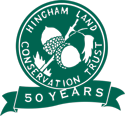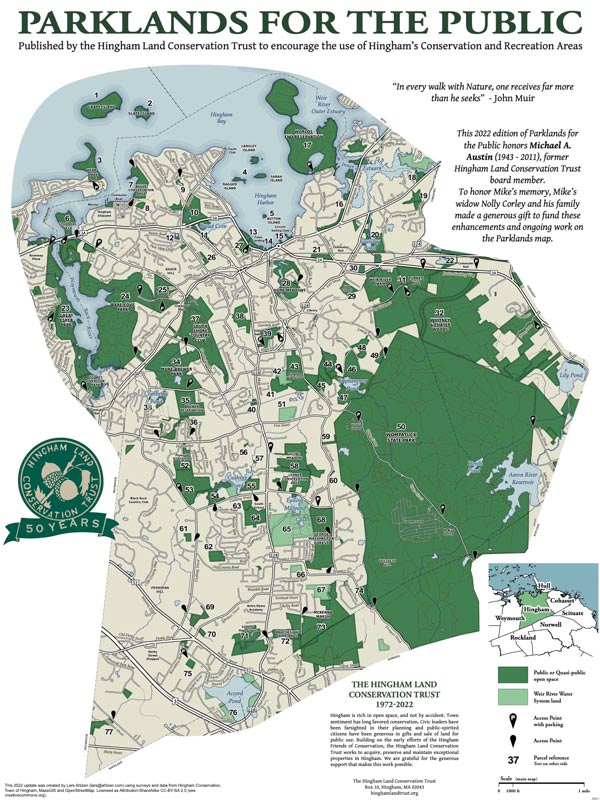The walks site consists of two parcels: the Foundry Pond site which is owned by the Town of Hingham, and the Glastonbury Abbey site which is privately owned by the Abbey. The Foundry Pond/Glastonbury Abbey site is located between Kilby Street and residential property on the west, the Greenbush Railroad line on the south, Hull Street on the east, and private property and Rockland Street on the north. The Foundry Pond and Abbey parcels are separated by Weir Street which runs from north to south between the parcels.
Both Native Americans and colonists used weirs to catch herring, and that’s how the river got its name. The Weir River runs through Hingham, and is fed from the south by Accord Brook, which flows from Accord Pond to the Weir River and on into the Weir River Estuary. The estuary connects the Weir River from the Foundry Pond Dam and Straits Pond to Hingham Bay at the northern end of World’s End in Hingham and Sunset Point in Hull. The herring run at Foundry Pond is impacted by upstream water withdrawals that lower streamflow in the summer and fall when juvenile herring are migrating downstream. In addittion, the dam and its fish ladder are not ideal for fish passage.
A large expanse of granite is located on both the Foundry Pond and Glastonbury Abbey properties east of the Weir River/Foundry Pond. Foundry Pond was created by damming the Weir River, most likely in the late 18th Century. The dam was used sequentially to power the Hingham Malleable Iron Company (1840-1876) and Colonel Weston’s wool processing factory (until 1888). They were each destroyed by fire. Most of the area east of the pond to Weir Street was used as a granite quarry. The Sportsman’s Club acquired the pond for fishing and later sold the 32-acre parcel to the Town of Hingham.
The railroad along the west side of the properties, now known as the Greenbush Line, was constructed in 1849. As a result of the construction, Weir Street, which ran from East Street to Rockland Street was blocked at the railroad crossing. The Weir River was directed through a culvert, further disrupting fish migration.
The Abbey property was once the Hingham summer estate of wool merchant William Skilton. Mr. Skilton had his residence on the north side of the railroad tracks near Hull Street. At this location he had a rail siding where he kept his personal rail coach. Skilton, a bachelor, died in the early 1930s. The estate had been used as an inn and dance parlor, bachelor officers’ quarters for the town’s WW II Navy Ammunition Depot, and a day camp.
The Benedictine Fathers bought the Glastonbury Abbey Property in 1963. Glastonbury Abbey was founded in 1954 by Benet Lake Abbey, Wisconsin. Both of these monasteries belong to the family of the Swiss-American Benedictine Congregation which is part of the world-wide Benedictine Confederation. Benedictine monasticism takes its roots in the life of Saint Benedict (480-547 A.D.), patriarch of western monasticism and has flourished in Europe, Asia, Africa, Australia and the Americas. The life of a monastery centers on prayer and contemplation but also practices hospitality to its many guests. The Benet Lake monks named the new monastery for the famous medieval English abbey that by tradition is associated with the King Arthur legends. (The original Glastonbury Abbey was closed by King Henry VIII in 1539.)
After purchasing the property in 1963, the abbey started with “five or six” monks who lived and worked in the residence and former carriage house of the estate. In its early years, Glastonbury conducted a Latin School for seminarians. In 1975 a retreat ministry was begun. The retreat program opened in 1975, with the addition of rooms in a former nursing home just down the road. They bought a second nearby house in 1974, and in 2001 opened the Morcone Conference Center for lectures and other events, including family gatherings and wedding receptions. In 2006 the abbey church was renovated and enlarged to give greater emphasis to worship and allow more worshippers to visit. The abbey now includes 40 acres and eight buildings.
Features on the Glastonbury property include a small labyrinth, a 70-foot, stone observation tower, a cemetery and a community garden. A sizable group of lay volunteers helps the monks tend to the community garden and gather the produce, which is donated to Hull’s Wellspring social services agency and other food pantries. There are also bee hives and a family of goats, brought in by the abbey’s longtime chef to produce honey and cheese. Also, on the Glastonbury property trails through the woods, there are benches and monuments
On the Foundry Pond property there are interesting fish and vegetation. Some of the fish that might be found in the pond include river herring, smelt, brown trout (stocked from Europe), brook trout, largemouth bass, redfin pickerel, bluegill, pumpkinseed sunfish and American eel. The forest here is composed of pine, oak and cedar, plus some bittersweet and holly. There is also marshland, with plenty of cattails.
Seasonal hunting is permitted on this property with a town-issued permit. Hunting is prohibited on Sundays. See the hunting pages on Hingham’s website for details.
Access to the Foundry Pond trails is on Weir Street. Traveling east on Rockland Street, after passing Kilby Street, turn onto either Cherry Street or Canterbury Street onto Weir Street. Travel south on Weir Street passing a pond on the left. The entrance to Foundry Pond, which is marked by a sign, is on the right, 100+/- feet before coming to a gate across Weir Street. Park on the side of the road without blocking access to the entrance gate or through traffic. Access to Glastonbury Abbey is via a parking lot on the Abbey property. The lot is on the west side of the street, north of the railroad crossing, across from 27 Hull Street. Access, from Kilby Street on the west side of the pond, principally used for fishing, is located between 97 and 101 Kilby Street.
To get to the Foundry Pond area entrance, travel on Rockland Street from Kilby Street towards Hull Street, and pass over the Weir River, turn right onto Cherry Street and continue right onto Weir Street. The entrance, which is gated and marked by a sign, is across the street from 85 Weir Street. Public vehicle access is not allowed beyond 85 Weir Street. There is street side parking available for several cars at the entrance. The entrance must remain unobstructed for emergency access.
Enter The Foundry Pond Area by the sign and follow the trail into the woods. After a short distance the land drops off on both sides of the trail. There are a couple of overlooks on the left of the trail with views of the rocky quarry and ponds. The trail comes to a split with forest on both sides. Follow the route to the right uphill over a rocky outcrop and a short boardwalk. The trail splits again with the route remaining on the right and dropping down to the end of the dam. On this side of the dam is a fish ladder primarily for herring migrating upstream in spring. Turn left at the dam and follow the shoreline through the woods. The dam and shoreline are good locations for observing seabirds. The trail becomes narrow, and rocky rolling up and down hill. Stay left at the split and head uphill. The trail merges with another trail then drops steeply to merge with another trail. Continuing along the edge of the pond the trail passes through a wet area and over a small stream with a marsh along the river side on the right. The trail curves to the left (east) and rises up through rocky outcrops. Follow the route to the left and head downhill until you approach another split. At this point the Greenbush Line Railroad track is on the right and there are some views of the quarry from the 15 foot high rises on the left side of the trail. The trail continues parallel to the railroad tracks and rises steadily to Weir Street. (At this location Weir Street heads left, back towards Rockland Street and right, continuing next to the railroad track. At one time Weir Street continued across the railroad right of way and connected to East Street. However the street was discontinued when the railroad was built. A section of Weir street still exists on the East Street side of the railroad tracks.
Turn left onto Weir Street with views down to the quarry through a chain link fence on the left. On the right side of the road are forests and a gated entrance to the Glastonbury Abbey property.
The route passes through a gate across Weir Street and ends at the entrance to the Foundry Pond Area.

Recommended Trail Activities: Walking, Hiking, Trail Biking Length: .6 Route Type: Trail (Narrow), Path (Medium), Road (Wide) Difficulty (Grade/Surface): Easy, Moderate Parking: Minimal (1-5 spaces) Dog Restrictions: Allowed Ancillary Activities: Snowshoeing, Birding, Boating, Fishing (license may be required), Hunting (permission may be required), Camping (permission may be required), Picnic, Natural Features, Historic Sites


